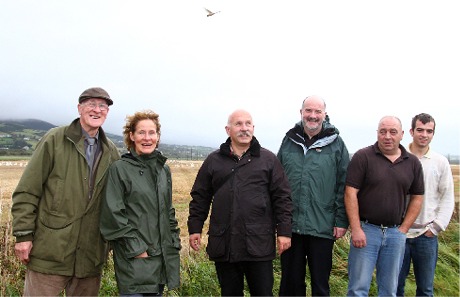|
|
Biology experts eye Inch Lake
03.11.10
by Damian Dowds, Inishowen Independent
A HIGH powered delegation visited Inishowen last
week to examine whether Inch Lake in particular, and
the Inishowen peninsula in general, can be
designated as wetlands of international importance.
Tobias Salathe, the European director of the Ramsar
Convention, and Karin Dubsky, a marine biologist at
Trinity College, Dublin and member of Coastwatch
Ireland, visited both Lough Swilly and Lough Foyle
on Tuesday in what has been described as the first
step in securing this ‘quality mark’ for the local
area. They met with local wildlife experts, and also
the Loughs Agency, to discuss upgrading the
designation of the wetlands on the Swilly and Foyle.
Tens of thousands of birds winter on the Inch Lake
and surrounding areas making it an area of
international importance for rare birds, including
Whooper Swans, Greylag geese, Greenland white
fronted geese and the Sandwich Tern.
“This is the first step towards getting ‘Ramsar’
designation,” Dermot McLaughlin, a retired wildlife
ranger and chairman of the Inishowen Wildlife Club
said. “Inch Lake is of international importance, but
getting this designation would give even greater
international recognition.”
Almost 2,000 such sites around the world are
protected by the Ramsar Convention, which is an
international treaty (named after the Iranian town
in which it was first adopted back in 1971) for the
conservation and sustainable use of wetlands. |
 |
|
The biology experts visiting Inch Lake. |
“Mr Salathe was on a
three day visit to Ireland, and that he spent a day
here in Inishowen and the other two in meetings in
Dublin, tells you just how highly regarded Inch Lake
and its bird population is,” Mr McLaughlin
continued. “He was very impressed with Inch Lake
Nature Reserve, its facilities and the biodiversity
that exits here. We have four species of
international importance and 20 species of national
importance here.”
Thousands of swans and geese have arrived at Inch
Lake in the last week, creating a spectacular sight
– and a real racket a night.
“The freshwater lake is a manmade one and dates from
the 1860s,” Mr McLaughlin said. “Indeed, the whole
area, from Blanketnook to Tooban, is man managed and
Donegal Creameries and the National Parks and
Wildlife Service do a tremendous job in maintaining
it.”
“The birds will feed on the loose grain amongst the
barley stubble first, and then move onto the potato
fields which are being harvested now.
“It’s a really spectacular sight, especially at dusk
when they fill the air as they come home to roost.” |
|

